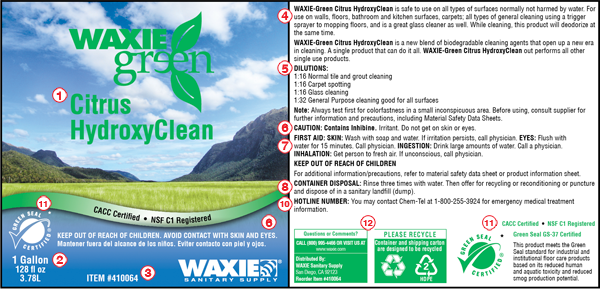Reading the product label should be the first step in the cleaning process, not only to make sure the directions are understood, but most importantly for safety. It’s best to also have the material safety data sheets (MSDS) on hand to read at the same time so that all safety and protective information is clearly understood prior to chemical usage. The product labels and MSDS will list any precautions or protective gear the user will need, and whether or not any other cleaning chemicals will be dangerous to use at the same time (like using a bleach product and an ammonia product in quick succession).
All chemical manufacturers should provide a MSDS upon request. WAXIE even makes chemical MSDS available for download online at anytime day or night on our website: 
Most product labels have the following info on them: product name, net contents, general info about the cleaning chemical, usage directions, dilution ratios (if not a ready-to-use product), precautionary statements, first aid statements, container storage & disposal, HMIS/NFPA ratings, third-party certification(s) (if applicable), emergency hotline number and manufacturer’s address.
Disinfectant & pesticide labels contain even more information due to EPA regulations, which include a list of ingredients (active & inert), kill claims, specific usage directions depending on the listed kill claims and an EPA registration number.
EPA's Website:
Breaking It All Down...

Portion of the WAXIE-Green Citrus HydroxyClean label (click to view larger)
1) Product Name: Identifies the product.
2) Net Contents: Tells how much product is in the container.
3) Item Number: Identifies the product number for reordering.
4) General Product Info: Describes what the product is used for.
5) Directions &/or Dilution Ratios: Describes how to safely use the product; on more complicated labels, like disinfectant labels, the directions will be more extensive for each product usage category. If the product is not ready-to-use, a list of dilution ratios indicate what dilution is needed for the desired application (the number depends on how many ways the product can be used). Ratios are shown 1 part water to a specified concentrated chemical amount, such as 1:32 for the general purpose surface cleaning application for the above WAXIE-Green Citrus HydroxyClean product.
6) Precautionary Statements: Watch out for words like ‘Danger’, ‘Warning’ or ‘Caution’ as they signal potential hazards and how to avoid them when using the chemical. Sometimes warnings can be listed on the front & back panels of the label for extra emphasis. Notice that KEEP OUT OF REACH OF CHILDREN is in bold and in all capitals as that is very important information. Caution is the least harmful & danger is the most harmful signal word.
7) First Aid Info: Practical first aid treatment info in case a chemical gets on the skin, in the eyes, is ingested or inhaled.
8) Container Storage &/or Disposal: Indicates the proper way to store a chemical or dispose of the chemical after the container is empty.
9) HMIS/NFPA Rating Info: Shown on label sample below. Hazardous Materials Identification System (HMIS) & National Fire Protection Association (NFPA) rating systems describes the severity of risks in a hazard rating system. Both systems rate a product from 0-4 with 0 meaning that a product poses no threat and 4 being very dangerous to the user. Both ratings can be color-coded, but not always. Categories are Health, Flammability, Physical Hazard &/or Reactivity, and Personal Protection. A diluted chemical typically has a lower rating. The HMIS rating system is usually shown as a bar, whereas the NFPA rating system is shown in the familiar “fire diamond” pattern. NFPA is used by emergency personnel to quickly identify the risks of hazardous materials, whereas the HMIS rating is used for more general health warning information. WAXIE lists both in a chart on labels for easy reference.
Hazardous Materials Identification System (HMIS) Rating System
NFPA 704 Rating System Information
 10) Hotline Number: Emergency medical information telephone number that can be called 24/7.
10) Hotline Number: Emergency medical information telephone number that can be called 24/7.
11) Third-Party Certification (if applicable): Lists logos/certifications of third-party certifiers for a product. For more info on ecolabels & certifications.
12) Manufacturer’s Info: Lists the contact info of the product’s manufacturer or distributor.

Example of a disinfectant label (click to view larger)
13) List of Ingredients (Active & Inert): Some labels, like disinfectant labels, list the chemical’s active & inert ingredients along with the percentage of each amount in the chemical’s composition. Inert ingredients (sometimes listed as “other ingredients”) are included in a chemical’s composition for various reasons, such as assisting when diluting a chemical with water, product activity, viscosity, etc.
14) Kill Claims: If the chemical kills certain bacteria, viruses, fungi, mold, mildew, pests, etc. there will be a list of kill claims. These kill claims are ONLY effective if a product is used as directed on the label.
15) EPA Registration Number: Disinfectants & pesticides need to be registered with the EPA. Each product that is reviewed and registered is given a number, which indicates that the EPA deems that the product can be used with minimal harm if the product is used properly in the manner described on the product label.
